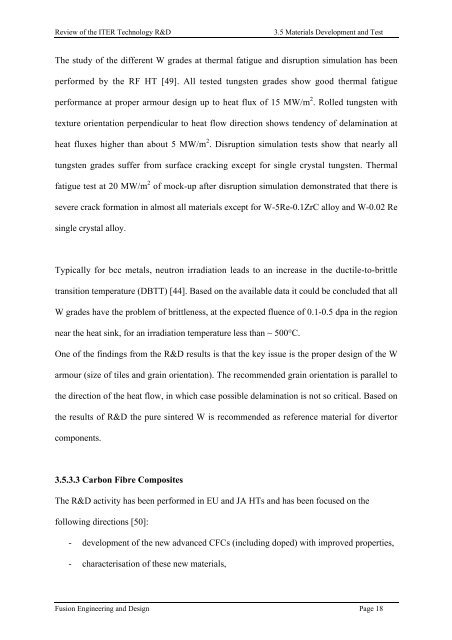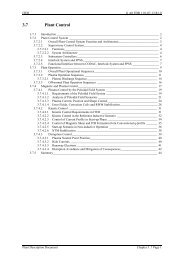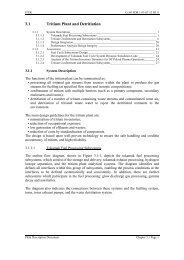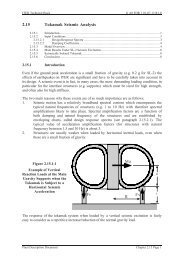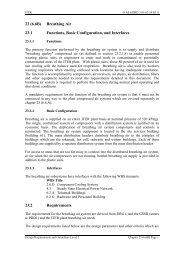3.5. Materials Development and Test Introduction Materials R&D for ...
3.5. Materials Development and Test Introduction Materials R&D for ...
3.5. Materials Development and Test Introduction Materials R&D for ...
You also want an ePaper? Increase the reach of your titles
YUMPU automatically turns print PDFs into web optimized ePapers that Google loves.
Review of the ITER Technology R&D<br />
3.5 <strong>Materials</strong> <strong>Development</strong> <strong>and</strong> <strong>Test</strong><br />
The study of the different W grades at thermal fatigue <strong>and</strong> disruption simulation has been<br />
per<strong>for</strong>med by the RF HT [49]. All tested tungsten grades show good thermal fatigue<br />
per<strong>for</strong>mance at proper armour design up to heat flux of 15 MW/m 2 . Rolled tungsten with<br />
texture orientation perpendicular to heat flow direction shows tendency of delamination at<br />
heat fluxes higher than about 5 MW/m 2 . Disruption simulation tests show that nearly all<br />
tungsten grades suffer from surface cracking except <strong>for</strong> single crystal tungsten. Thermal<br />
fatigue test at 20 MW/m 2 of mock-up after disruption simulation demonstrated that there is<br />
severe crack <strong>for</strong>mation in almost all materials except <strong>for</strong> W-5Re-0.1ZrC alloy <strong>and</strong> W-0.02 Re<br />
single crystal alloy.<br />
Typically <strong>for</strong> bcc metals, neutron irradiation leads to an increase in the ductile-to-brittle<br />
transition temperature (DBTT) [44]. Based on the available data it could be concluded that all<br />
W grades have the problem of brittleness, at the expected fluence of 0.1-0.5 dpa in the region<br />
near the heat sink, <strong>for</strong> an irradiation temperature less than ~ 500°C.<br />
One of the findings from the R&D results is that the key issue is the proper design of the W<br />
armour (size of tiles <strong>and</strong> grain orientation). The recommended grain orientation is parallel to<br />
the direction of the heat flow, in which case possible delamination is not so critical. Based on<br />
the results of R&D the pure sintered W is recommended as reference material <strong>for</strong> divertor<br />
components.<br />
<strong>3.5.</strong>3.3 Carbon Fibre Composites<br />
The R&D activity has been per<strong>for</strong>med in EU <strong>and</strong> JA HTs <strong>and</strong> has been focused on the<br />
following directions [50]:<br />
- development of the new advanced CFCs (including doped) with improved properties,<br />
- characterisation of these new materials,<br />
Fusion Engineering <strong>and</strong> Design Page 18


